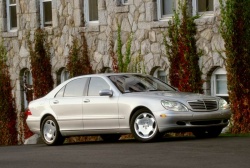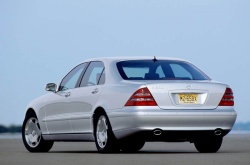 2004 Mercedes-Benz S600. Click image to enlarge |
|
Related articles on Autos
Manufacturer’s web site
|
By Chris Chase; photos courtesy Mercedes-Benz
Find this vehicle in Autos’s Classified Ads
Photo Gallery:
Mercedes-Benz S-Class, 2000-2006
As with many Mercedes-Benz models, the S-Class can trace its roots back many decades, but it wasn’t until 1973 that the company officially adopted the S-Class name for its largest sedan.
Fast forward four generations to 2000, when the generation of S-Class codenamed W220 was introduced. The W220 was smaller outside than its predecessor, yet it offered more interior space.
While the S-Class was offered with a wide variety of engines in other markets, North American versions were all offered with V8 power.
In 2000, there were 4.3-litre (275 hp) and 5.0-litre (302 hp) engines (used in the S430 and S500 models, respectively); Mercedes added a 5.5-litre V8 (349 hp) and a 5.8-litre V12 (362 hp) in 2002 to power the S55 AMG and S600.
In 2003, the 4MATIC all-wheel drive system was made available in the S430 and S500, while the S55 and S600 both got serious bumps in power. The S55 got a supercharged 5.5-litre V8 making 493 hp and 516 lb-ft of torque, while the S600 benefitted from a turbocharged 5.5-litre V12 also making 493 hp, along with an awesome 590 lb-ft of torque.
Though the W220 carried on much the same through 2006, the S500 was replaced by an S550 wearing the next-gen S-Class’ design, and the S65 AMG with an outrageous turbocharged 6.0-litre V12 making 604 hp(!) and 738 lb-ft of torque(!!), was added to the top of the range.
 2004 Mercedes-Benz S600. Click image to enlarge |
In early cars, a five-speed automatic was the only transmission offered. A seven-speed was made standard in rear-drive S430 and S500 models starting in 2004, while all-wheel drive cars and the higher-performance models got the old five-speed.
In 2005, the S430 was sold only in 4MATIC/seven-speed form, the S500 could be had in either RWD or AWD form (but AWD versions could only be had with the five-speed), and the S55 and S600 only came with the five-speed and rear-wheel drive.
To confuse things further, in 2006, only the new-bodystyle S550 used the seven-speed, while all other S-Class models used the five-speed.
The S430 was the only one offered in a short-wheelbase version, while the “regular” length model was 100 mm (about four inches) longer between the front and rear wheels.
As with any prestige automobile, the prospect of out-of-warranty repairs brings with it significant costs: by all accounts, the W220 S-Class isn’t without reliability issues, but the trouble spots appear to be well-documented by enthusiasts in Mercedes online discussion forums.
This W220 Encyclopedia at BenzWorld.org should be your starting point for research into what problems are likely in a used S-Class of this generation.
Here is another “what to look for” thread, while this one focuses on the Airmatic suspension.
The “Airmatic” air suspension system appears to be the source of some issues, but most problems can be linked to leaks in the system. A bad enough leak can cause the system’s pneumatic pump to run constantly and burn out; a slower leak will simply result in the air leaking out if the car sits undriven for a few days, but will have less effect on the system’s performance when the car is running. Leaks are common in the front struts, but Mercedes apparently makes a repair kit that fixes the problem relatively inexpensively. This very informative post at BenzWorld.org suggests that the Airmatic suspension is the source of most problems in this generation of S-Class.







 Follow Autos on Twitter
Follow Autos on Twitter



